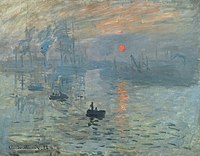
Photo from wikipedia
Play is a significant event and opportunity for experience and discovery for children to find their place in the society, to search for themselves and their identity. This study aimed… Click to show full abstract
Play is a significant event and opportunity for experience and discovery for children to find their place in the society, to search for themselves and their identity. This study aimed to analyze how the images of children and play were reflected on impressionist painting in Europe in the 19th century. First, the works of impressionist painters were analyzed because they contain concrete and understandable images. According to the impressionist movement, the artist should give prominence to their personal interpretations and the emotions and the thoughts evoked by what they see instead of being objective and directly reflecting the reality. Children play in such a way. This qualitative study examined the images of children and play in 35 works of 10 impressionist painters within the context of the cultural play. Results indicated that, in the 35 paintings studied, children were depicted mostly in open, natural enviroments or social settings. Most of the children were depicted as girls of high socio-economical appearance and alone. Dolls, sensory toys, hoops, and animal toys were observed frequently. The most common type of play was symbolic. The findings suggest that arts also reflect the child play as a cultural value under the conditions of a certain period. This study traces the historical marks of children and play in art and offers insights for today’s early education.
Journal Title: Creativity Research Journal
Year Published: 2018
Link to full text (if available)
Share on Social Media: Sign Up to like & get
recommendations!